A Comparative Analysis: EVH vs OVH Outcomes in CABG Patients - Report
VerifiedAdded on 2020/03/28
|20
|4371
|284
Report
AI Summary
This report critically evaluates the mid-term and long-term outcomes of Endoscopic Vein Harvest (EVH) compared to Open Vein Harvest (OVH) in Coronary Artery Bypass Grafting (CABG) patients. It begins with an introduction to CABG and the two vein harvesting methods, highlighting EVH's minimally invasive approach and potential benefits, while acknowledging concerns about graft patency. A literature search was conducted using Ovid (Medline) and PubMed, focusing on articles published between 2008 and 2017. Two articles were selected and critically appraised using the CASP tool to compare the outcomes of EVH and OVH. The literature review summarizes the strengths and weaknesses of each article, including the use of appropriate citations and statistical data. The report also examines the research methodology, including the case-control study designs used in the selected articles and the tools/instruments used for data collection. The target population and sampling methods are discussed, along with the limitations of not measuring reliability and validity. The report concludes by synthesizing the findings and offering insights into the applicability of EVH and OVH in clinical practice, based on the available evidence.
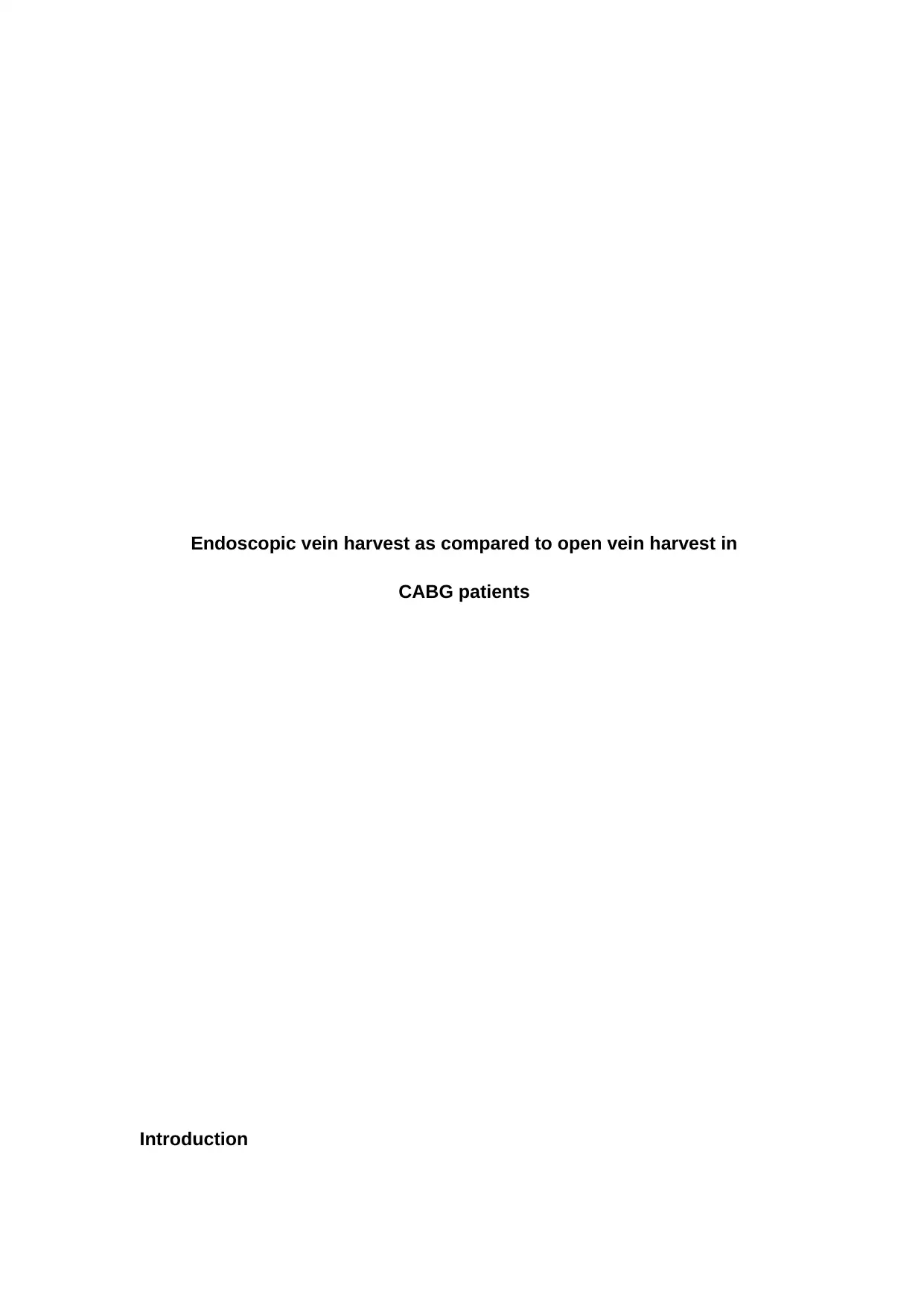
Endoscopic vein harvest as compared to open vein harvest in
CABG patients
Introduction
CABG patients
Introduction
Paraphrase This Document
Need a fresh take? Get an instant paraphrase of this document with our AI Paraphraser
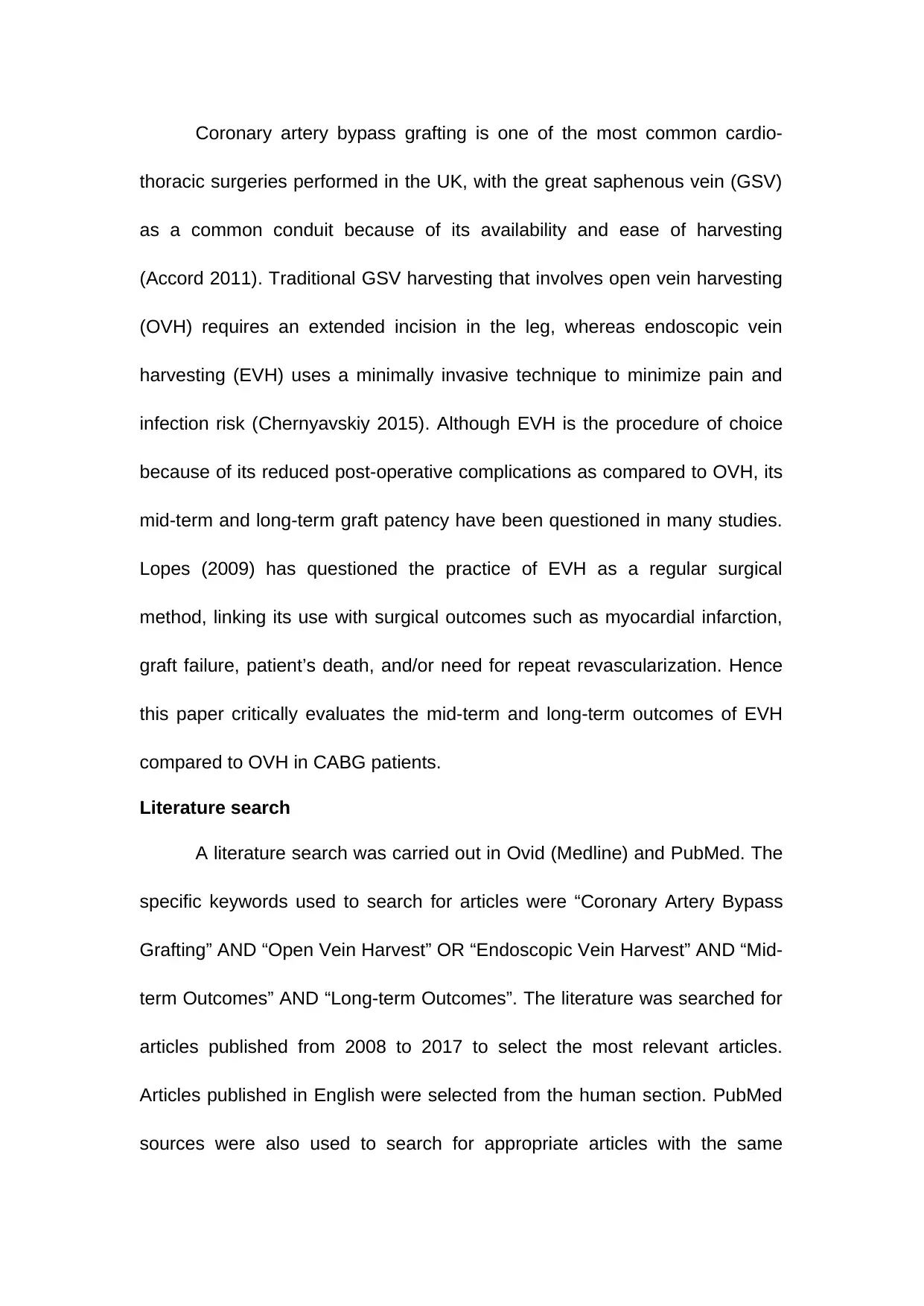
Coronary artery bypass grafting is one of the most common cardio-
thoracic surgeries performed in the UK, with the great saphenous vein (GSV)
as a common conduit because of its availability and ease of harvesting
(Accord 2011). Traditional GSV harvesting that involves open vein harvesting
(OVH) requires an extended incision in the leg, whereas endoscopic vein
harvesting (EVH) uses a minimally invasive technique to minimize pain and
infection risk (Chernyavskiy 2015). Although EVH is the procedure of choice
because of its reduced post-operative complications as compared to OVH, its
mid-term and long-term graft patency have been questioned in many studies.
Lopes (2009) has questioned the practice of EVH as a regular surgical
method, linking its use with surgical outcomes such as myocardial infarction,
graft failure, patient’s death, and/or need for repeat revascularization. Hence
this paper critically evaluates the mid-term and long-term outcomes of EVH
compared to OVH in CABG patients.
Literature search
A literature search was carried out in Ovid (Medline) and PubMed. The
specific keywords used to search for articles were “Coronary Artery Bypass
Grafting” AND “Open Vein Harvest” OR “Endoscopic Vein Harvest” AND “Mid-
term Outcomes” AND “Long-term Outcomes”. The literature was searched for
articles published from 2008 to 2017 to select the most relevant articles.
Articles published in English were selected from the human section. PubMed
sources were also used to search for appropriate articles with the same
thoracic surgeries performed in the UK, with the great saphenous vein (GSV)
as a common conduit because of its availability and ease of harvesting
(Accord 2011). Traditional GSV harvesting that involves open vein harvesting
(OVH) requires an extended incision in the leg, whereas endoscopic vein
harvesting (EVH) uses a minimally invasive technique to minimize pain and
infection risk (Chernyavskiy 2015). Although EVH is the procedure of choice
because of its reduced post-operative complications as compared to OVH, its
mid-term and long-term graft patency have been questioned in many studies.
Lopes (2009) has questioned the practice of EVH as a regular surgical
method, linking its use with surgical outcomes such as myocardial infarction,
graft failure, patient’s death, and/or need for repeat revascularization. Hence
this paper critically evaluates the mid-term and long-term outcomes of EVH
compared to OVH in CABG patients.
Literature search
A literature search was carried out in Ovid (Medline) and PubMed. The
specific keywords used to search for articles were “Coronary Artery Bypass
Grafting” AND “Open Vein Harvest” OR “Endoscopic Vein Harvest” AND “Mid-
term Outcomes” AND “Long-term Outcomes”. The literature was searched for
articles published from 2008 to 2017 to select the most relevant articles.
Articles published in English were selected from the human section. PubMed
sources were also used to search for appropriate articles with the same
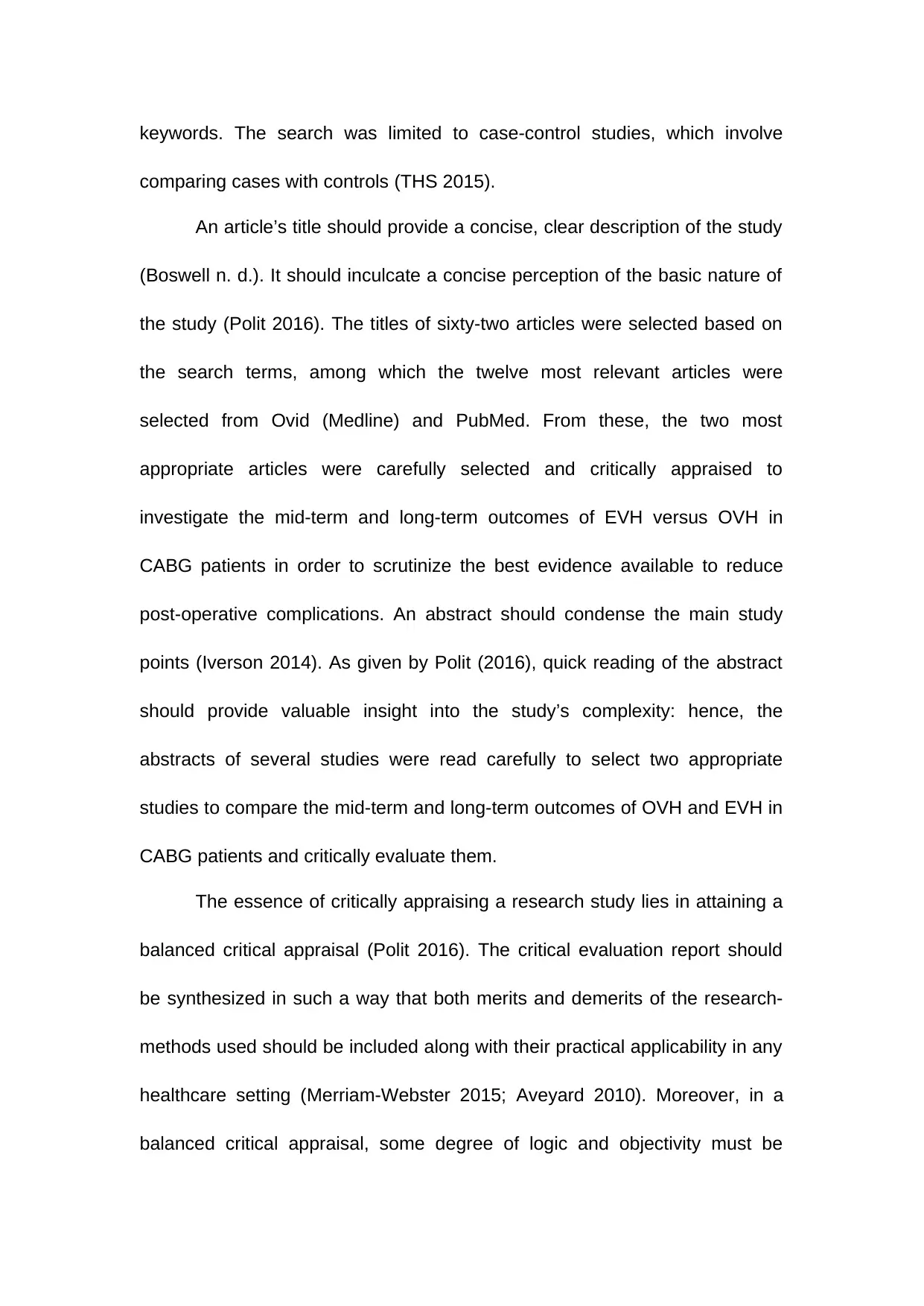
keywords. The search was limited to case-control studies, which involve
comparing cases with controls (THS 2015).
An article’s title should provide a concise, clear description of the study
(Boswell n. d.). It should inculcate a concise perception of the basic nature of
the study (Polit 2016). The titles of sixty-two articles were selected based on
the search terms, among which the twelve most relevant articles were
selected from Ovid (Medline) and PubMed. From these, the two most
appropriate articles were carefully selected and critically appraised to
investigate the mid-term and long-term outcomes of EVH versus OVH in
CABG patients in order to scrutinize the best evidence available to reduce
post-operative complications. An abstract should condense the main study
points (Iverson 2014). As given by Polit (2016), quick reading of the abstract
should provide valuable insight into the study’s complexity: hence, the
abstracts of several studies were read carefully to select two appropriate
studies to compare the mid-term and long-term outcomes of OVH and EVH in
CABG patients and critically evaluate them.
The essence of critically appraising a research study lies in attaining a
balanced critical appraisal (Polit 2016). The critical evaluation report should
be synthesized in such a way that both merits and demerits of the research-
methods used should be included along with their practical applicability in any
healthcare setting (Merriam-Webster 2015; Aveyard 2010). Moreover, in a
balanced critical appraisal, some degree of logic and objectivity must be
comparing cases with controls (THS 2015).
An article’s title should provide a concise, clear description of the study
(Boswell n. d.). It should inculcate a concise perception of the basic nature of
the study (Polit 2016). The titles of sixty-two articles were selected based on
the search terms, among which the twelve most relevant articles were
selected from Ovid (Medline) and PubMed. From these, the two most
appropriate articles were carefully selected and critically appraised to
investigate the mid-term and long-term outcomes of EVH versus OVH in
CABG patients in order to scrutinize the best evidence available to reduce
post-operative complications. An abstract should condense the main study
points (Iverson 2014). As given by Polit (2016), quick reading of the abstract
should provide valuable insight into the study’s complexity: hence, the
abstracts of several studies were read carefully to select two appropriate
studies to compare the mid-term and long-term outcomes of OVH and EVH in
CABG patients and critically evaluate them.
The essence of critically appraising a research study lies in attaining a
balanced critical appraisal (Polit 2016). The critical evaluation report should
be synthesized in such a way that both merits and demerits of the research-
methods used should be included along with their practical applicability in any
healthcare setting (Merriam-Webster 2015; Aveyard 2010). Moreover, in a
balanced critical appraisal, some degree of logic and objectivity must be
⊘ This is a preview!⊘
Do you want full access?
Subscribe today to unlock all pages.

Trusted by 1+ million students worldwide

utilized to identify the systematic enquiry underpinning the study (Boswell n.
d.). A framework is a visual tool that is used to frame questions that assist in
assessing the value of the paper being critiqued (Baker 2014). Several such
tools are available, including the Critical Appraisal Skills Programme tool
(CASP 2010), the Polit tools, Consolidated Standards for Reporting
ClinicalTrials (CONSORT 2010) and the PEDro scale (Schulz 2010).The
CASP was selected for this critique because it is highly appropriate for
critiquing case control studies (University of South Australia n. d.). In this
appraisal, two research articles were selected to discuss the mid-term and
long-term outcomes of EVH as compared to OVH in patients undergoing
CABG.
Article A
Kirmani et al. (2010).Mid-term outcomes for endoscopic versus open vein
harvest: a case control study: Journal of Cardiothoracic Surgery5:44.
Article B
Dacey, L.J et al. (2011).Long-term outcomes of endoscopic vein harvesting
after coronary artery bypass grafting: Circulation. 123:147-153. doi.
10.1161/CIRCULATIONAHA.110.960765
Literature Review
According to Polit (2016), a literature review is a critical summary of
research on a problem of interest that is framed to contextualise a study’s
problem. It should focus on the presented research problem (Boswell n. d.).
d.). A framework is a visual tool that is used to frame questions that assist in
assessing the value of the paper being critiqued (Baker 2014). Several such
tools are available, including the Critical Appraisal Skills Programme tool
(CASP 2010), the Polit tools, Consolidated Standards for Reporting
ClinicalTrials (CONSORT 2010) and the PEDro scale (Schulz 2010).The
CASP was selected for this critique because it is highly appropriate for
critiquing case control studies (University of South Australia n. d.). In this
appraisal, two research articles were selected to discuss the mid-term and
long-term outcomes of EVH as compared to OVH in patients undergoing
CABG.
Article A
Kirmani et al. (2010).Mid-term outcomes for endoscopic versus open vein
harvest: a case control study: Journal of Cardiothoracic Surgery5:44.
Article B
Dacey, L.J et al. (2011).Long-term outcomes of endoscopic vein harvesting
after coronary artery bypass grafting: Circulation. 123:147-153. doi.
10.1161/CIRCULATIONAHA.110.960765
Literature Review
According to Polit (2016), a literature review is a critical summary of
research on a problem of interest that is framed to contextualise a study’s
problem. It should focus on the presented research problem (Boswell n. d.).
Paraphrase This Document
Need a fresh take? Get an instant paraphrase of this document with our AI Paraphraser

Articles A and B clearly and concisely focused on their area of interest by
concentrating on EVH studies, as suggested by Iverson (2014). They both
quoted recent studies with correct in-text citations, except for a few studies in
Article B which are older than 10 years. Both articles provide unbiased
discussions of the literature, including studies of both the merits and demerits
of EVH, as advised by Iverson (2014). Article A could have quoted some
relevant statistics about the outcomes of EVH, whereas Article B provides
statistics about CABG performed with EVH grafting in eight medical centres in
the New England from 2004 to 2008, which is highly appropriate (Fig. 1).
The researchers should demonstrate their study insight by quoting
benchmark studies (Boswell n. d.). This is evident in both articles, which cite
benchmark studies about EVH. Article A cites appropriate studies and
critically discusses the advantages, disadvantages and mixed opinions about
EVH, while Article B quotes only one stronger study by Lopes (2009), and
also discusses the weakness of the EVH method with other appropriate
studies to enable discussion. This literature search in both articles fails to
identify an appropriate theoretical framework and no map/outline is given in
either study (Iverson 2014). The objective of a literature review is to describe
the known facts, mention knowledge gaps and establish the study’s
significance (Polit 2016). Both studies provide constructive and resourceful
literature reviews to clarify what has been done previously and what has to be
continued (Boswell n. d.). In the last paragraph, they clearly set out the need
concentrating on EVH studies, as suggested by Iverson (2014). They both
quoted recent studies with correct in-text citations, except for a few studies in
Article B which are older than 10 years. Both articles provide unbiased
discussions of the literature, including studies of both the merits and demerits
of EVH, as advised by Iverson (2014). Article A could have quoted some
relevant statistics about the outcomes of EVH, whereas Article B provides
statistics about CABG performed with EVH grafting in eight medical centres in
the New England from 2004 to 2008, which is highly appropriate (Fig. 1).
The researchers should demonstrate their study insight by quoting
benchmark studies (Boswell n. d.). This is evident in both articles, which cite
benchmark studies about EVH. Article A cites appropriate studies and
critically discusses the advantages, disadvantages and mixed opinions about
EVH, while Article B quotes only one stronger study by Lopes (2009), and
also discusses the weakness of the EVH method with other appropriate
studies to enable discussion. This literature search in both articles fails to
identify an appropriate theoretical framework and no map/outline is given in
either study (Iverson 2014). The objective of a literature review is to describe
the known facts, mention knowledge gaps and establish the study’s
significance (Polit 2016). Both studies provide constructive and resourceful
literature reviews to clarify what has been done previously and what has to be
continued (Boswell n. d.). In the last paragraph, they clearly set out the need
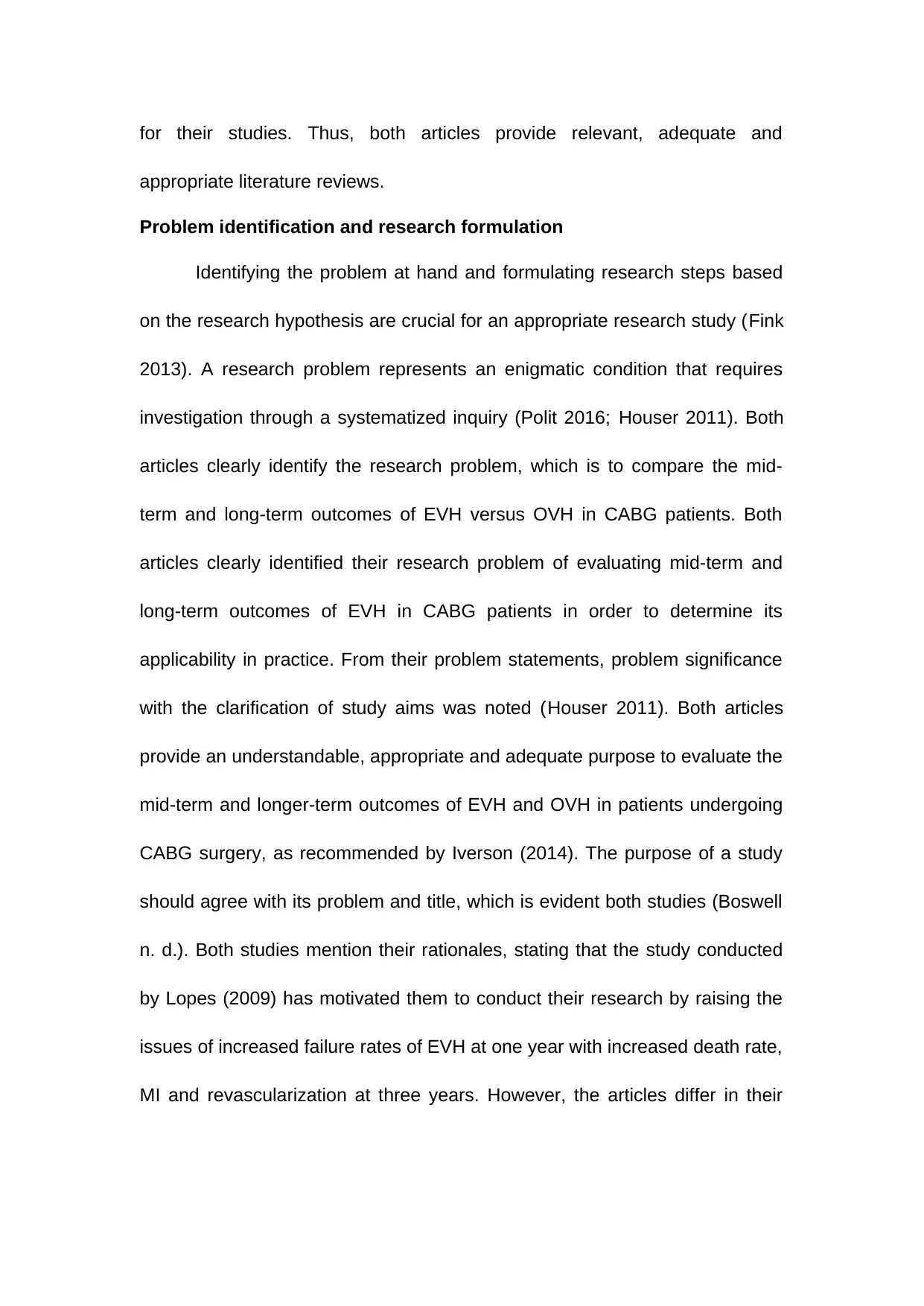
for their studies. Thus, both articles provide relevant, adequate and
appropriate literature reviews.
Problem identification and research formulation
Identifying the problem at hand and formulating research steps based
on the research hypothesis are crucial for an appropriate research study (Fink
2013). A research problem represents an enigmatic condition that requires
investigation through a systematized inquiry (Polit 2016; Houser 2011). Both
articles clearly identify the research problem, which is to compare the mid-
term and long-term outcomes of EVH versus OVH in CABG patients. Both
articles clearly identified their research problem of evaluating mid-term and
long-term outcomes of EVH in CABG patients in order to determine its
applicability in practice. From their problem statements, problem significance
with the clarification of study aims was noted (Houser 2011). Both articles
provide an understandable, appropriate and adequate purpose to evaluate the
mid-term and longer-term outcomes of EVH and OVH in patients undergoing
CABG surgery, as recommended by Iverson (2014). The purpose of a study
should agree with its problem and title, which is evident both studies (Boswell
n. d.). Both studies mention their rationales, stating that the study conducted
by Lopes (2009) has motivated them to conduct their research by raising the
issues of increased failure rates of EVH at one year with increased death rate,
MI and revascularization at three years. However, the articles differ in their
appropriate literature reviews.
Problem identification and research formulation
Identifying the problem at hand and formulating research steps based
on the research hypothesis are crucial for an appropriate research study (Fink
2013). A research problem represents an enigmatic condition that requires
investigation through a systematized inquiry (Polit 2016; Houser 2011). Both
articles clearly identify the research problem, which is to compare the mid-
term and long-term outcomes of EVH versus OVH in CABG patients. Both
articles clearly identified their research problem of evaluating mid-term and
long-term outcomes of EVH in CABG patients in order to determine its
applicability in practice. From their problem statements, problem significance
with the clarification of study aims was noted (Houser 2011). Both articles
provide an understandable, appropriate and adequate purpose to evaluate the
mid-term and longer-term outcomes of EVH and OVH in patients undergoing
CABG surgery, as recommended by Iverson (2014). The purpose of a study
should agree with its problem and title, which is evident both studies (Boswell
n. d.). Both studies mention their rationales, stating that the study conducted
by Lopes (2009) has motivated them to conduct their research by raising the
issues of increased failure rates of EVH at one year with increased death rate,
MI and revascularization at three years. However, the articles differ in their
⊘ This is a preview!⊘
Do you want full access?
Subscribe today to unlock all pages.

Trusted by 1+ million students worldwide
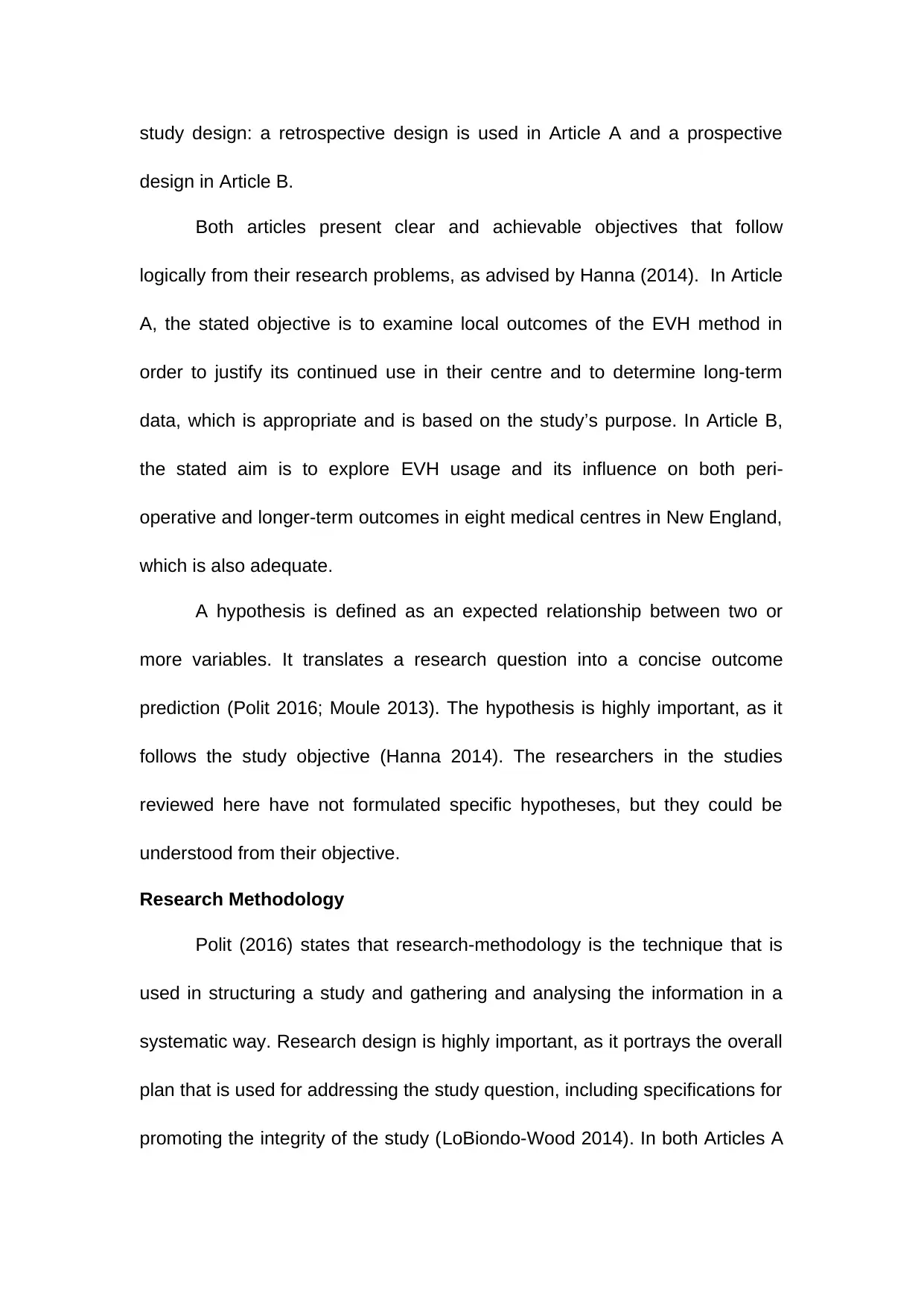
study design: a retrospective design is used in Article A and a prospective
design in Article B.
Both articles present clear and achievable objectives that follow
logically from their research problems, as advised by Hanna (2014). In Article
A, the stated objective is to examine local outcomes of the EVH method in
order to justify its continued use in their centre and to determine long-term
data, which is appropriate and is based on the study’s purpose. In Article B,
the stated aim is to explore EVH usage and its influence on both peri-
operative and longer-term outcomes in eight medical centres in New England,
which is also adequate.
A hypothesis is defined as an expected relationship between two or
more variables. It translates a research question into a concise outcome
prediction (Polit 2016; Moule 2013). The hypothesis is highly important, as it
follows the study objective (Hanna 2014). The researchers in the studies
reviewed here have not formulated specific hypotheses, but they could be
understood from their objective.
Research Methodology
Polit (2016) states that research-methodology is the technique that is
used in structuring a study and gathering and analysing the information in a
systematic way. Research design is highly important, as it portrays the overall
plan that is used for addressing the study question, including specifications for
promoting the integrity of the study (LoBiondo-Wood 2014). In both Articles A
design in Article B.
Both articles present clear and achievable objectives that follow
logically from their research problems, as advised by Hanna (2014). In Article
A, the stated objective is to examine local outcomes of the EVH method in
order to justify its continued use in their centre and to determine long-term
data, which is appropriate and is based on the study’s purpose. In Article B,
the stated aim is to explore EVH usage and its influence on both peri-
operative and longer-term outcomes in eight medical centres in New England,
which is also adequate.
A hypothesis is defined as an expected relationship between two or
more variables. It translates a research question into a concise outcome
prediction (Polit 2016; Moule 2013). The hypothesis is highly important, as it
follows the study objective (Hanna 2014). The researchers in the studies
reviewed here have not formulated specific hypotheses, but they could be
understood from their objective.
Research Methodology
Polit (2016) states that research-methodology is the technique that is
used in structuring a study and gathering and analysing the information in a
systematic way. Research design is highly important, as it portrays the overall
plan that is used for addressing the study question, including specifications for
promoting the integrity of the study (LoBiondo-Wood 2014). In both Articles A
Paraphrase This Document
Need a fresh take? Get an instant paraphrase of this document with our AI Paraphraser
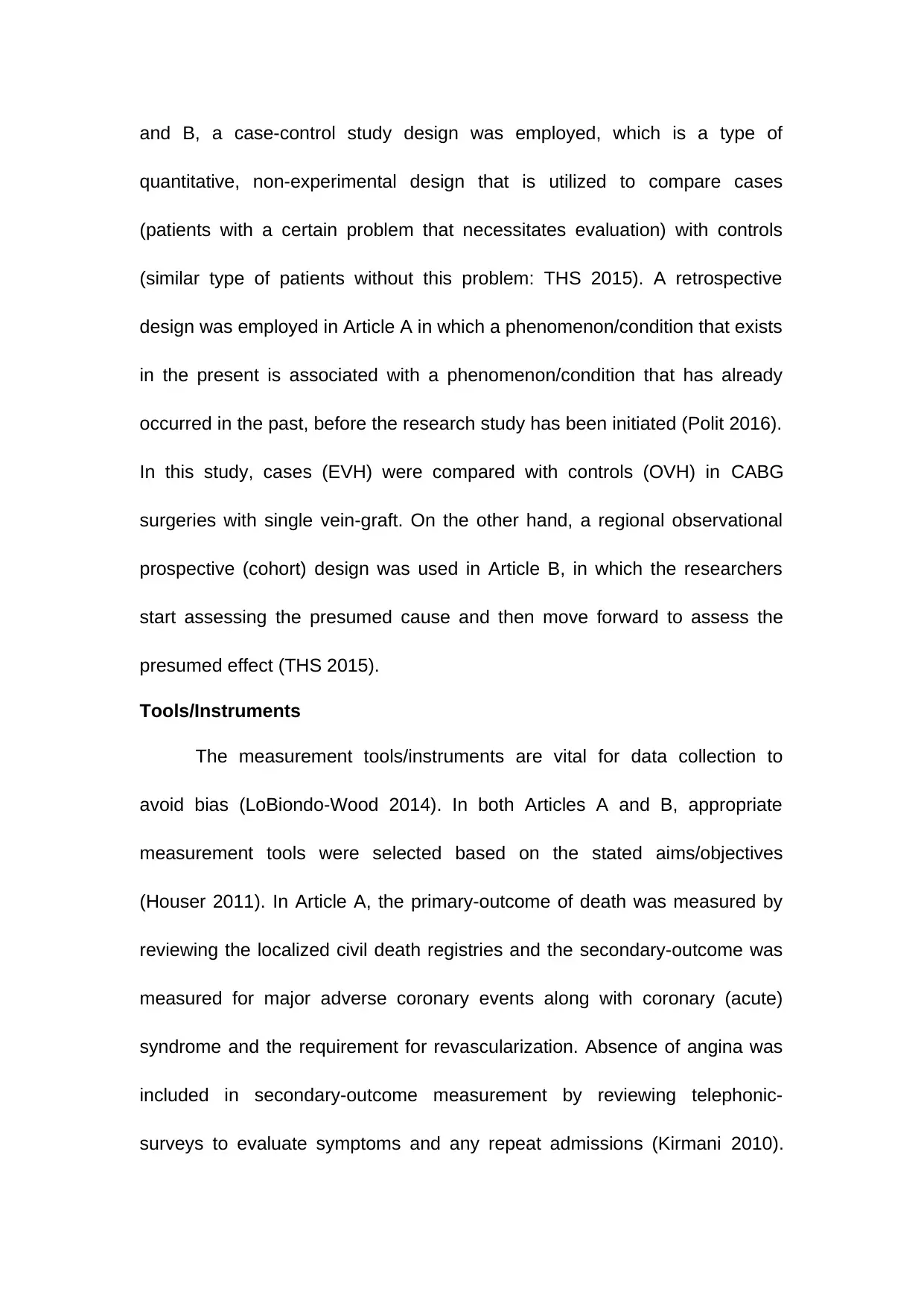
and B, a case-control study design was employed, which is a type of
quantitative, non-experimental design that is utilized to compare cases
(patients with a certain problem that necessitates evaluation) with controls
(similar type of patients without this problem: THS 2015). A retrospective
design was employed in Article A in which a phenomenon/condition that exists
in the present is associated with a phenomenon/condition that has already
occurred in the past, before the research study has been initiated (Polit 2016).
In this study, cases (EVH) were compared with controls (OVH) in CABG
surgeries with single vein-graft. On the other hand, a regional observational
prospective (cohort) design was used in Article B, in which the researchers
start assessing the presumed cause and then move forward to assess the
presumed effect (THS 2015).
Tools/Instruments
The measurement tools/instruments are vital for data collection to
avoid bias (LoBiondo-Wood 2014). In both Articles A and B, appropriate
measurement tools were selected based on the stated aims/objectives
(Houser 2011). In Article A, the primary-outcome of death was measured by
reviewing the localized civil death registries and the secondary-outcome was
measured for major adverse coronary events along with coronary (acute)
syndrome and the requirement for revascularization. Absence of angina was
included in secondary-outcome measurement by reviewing telephonic-
surveys to evaluate symptoms and any repeat admissions (Kirmani 2010).
quantitative, non-experimental design that is utilized to compare cases
(patients with a certain problem that necessitates evaluation) with controls
(similar type of patients without this problem: THS 2015). A retrospective
design was employed in Article A in which a phenomenon/condition that exists
in the present is associated with a phenomenon/condition that has already
occurred in the past, before the research study has been initiated (Polit 2016).
In this study, cases (EVH) were compared with controls (OVH) in CABG
surgeries with single vein-graft. On the other hand, a regional observational
prospective (cohort) design was used in Article B, in which the researchers
start assessing the presumed cause and then move forward to assess the
presumed effect (THS 2015).
Tools/Instruments
The measurement tools/instruments are vital for data collection to
avoid bias (LoBiondo-Wood 2014). In both Articles A and B, appropriate
measurement tools were selected based on the stated aims/objectives
(Houser 2011). In Article A, the primary-outcome of death was measured by
reviewing the localized civil death registries and the secondary-outcome was
measured for major adverse coronary events along with coronary (acute)
syndrome and the requirement for revascularization. Absence of angina was
included in secondary-outcome measurement by reviewing telephonic-
surveys to evaluate symptoms and any repeat admissions (Kirmani 2010).
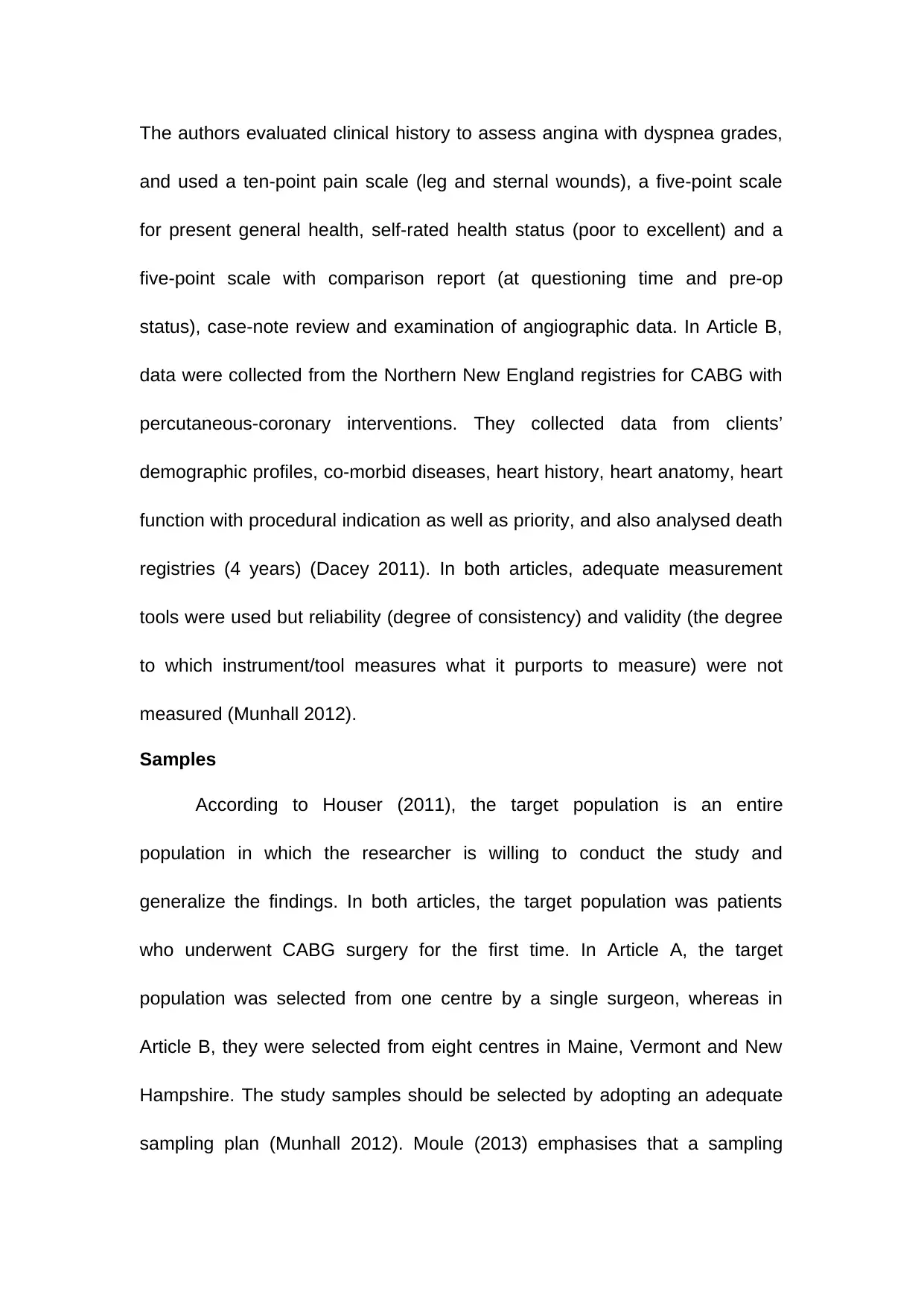
The authors evaluated clinical history to assess angina with dyspnea grades,
and used a ten-point pain scale (leg and sternal wounds), a five-point scale
for present general health, self-rated health status (poor to excellent) and a
five-point scale with comparison report (at questioning time and pre-op
status), case-note review and examination of angiographic data. In Article B,
data were collected from the Northern New England registries for CABG with
percutaneous-coronary interventions. They collected data from clients’
demographic profiles, co-morbid diseases, heart history, heart anatomy, heart
function with procedural indication as well as priority, and also analysed death
registries (4 years) (Dacey 2011). In both articles, adequate measurement
tools were used but reliability (degree of consistency) and validity (the degree
to which instrument/tool measures what it purports to measure) were not
measured (Munhall 2012).
Samples
According to Houser (2011), the target population is an entire
population in which the researcher is willing to conduct the study and
generalize the findings. In both articles, the target population was patients
who underwent CABG surgery for the first time. In Article A, the target
population was selected from one centre by a single surgeon, whereas in
Article B, they were selected from eight centres in Maine, Vermont and New
Hampshire. The study samples should be selected by adopting an adequate
sampling plan (Munhall 2012). Moule (2013) emphasises that a sampling
and used a ten-point pain scale (leg and sternal wounds), a five-point scale
for present general health, self-rated health status (poor to excellent) and a
five-point scale with comparison report (at questioning time and pre-op
status), case-note review and examination of angiographic data. In Article B,
data were collected from the Northern New England registries for CABG with
percutaneous-coronary interventions. They collected data from clients’
demographic profiles, co-morbid diseases, heart history, heart anatomy, heart
function with procedural indication as well as priority, and also analysed death
registries (4 years) (Dacey 2011). In both articles, adequate measurement
tools were used but reliability (degree of consistency) and validity (the degree
to which instrument/tool measures what it purports to measure) were not
measured (Munhall 2012).
Samples
According to Houser (2011), the target population is an entire
population in which the researcher is willing to conduct the study and
generalize the findings. In both articles, the target population was patients
who underwent CABG surgery for the first time. In Article A, the target
population was selected from one centre by a single surgeon, whereas in
Article B, they were selected from eight centres in Maine, Vermont and New
Hampshire. The study samples should be selected by adopting an adequate
sampling plan (Munhall 2012). Moule (2013) emphasises that a sampling
⊘ This is a preview!⊘
Do you want full access?
Subscribe today to unlock all pages.

Trusted by 1+ million students worldwide

plan, which is a formal plan for specifying the appropriate method, size and
procedures for selecting samples, is crucial.
A sample is a subset of a population which represents the entire
population group and is selected using an appropriate sampling process
(Boswell n. d.). In Article A, 271 eligible cases were selected, with 89 in the
EVH and 182 in the OVH group; in Article, B, 8542 patients were selected,
with 4480 in the EVH and 4062 in the OVH group. The selection of samples
within inclusion and exclusion criteria was adequate. It is likely that purposive
sampling (non-probability) was adopted in both articles to select patients with
EVH in the case groups and OVH in the control groups from patients who
underwent CABG with a single vein graft. However, neither set of authors has
mentioned their sampling technique in their text. Power calculation should be
performed to select the appropriate size of a sample (Polit 2016). This was
done in Article A to determine an adequate sample size of 326 in both groups
at a 95% confidence interval with 75% statistical power, whereas power
analysis was not done in Article B. However, as the sample size of Article B is
very large as compared to Article A, this is appropriate.
Ethics
Ethics are defined as the set of standards that are intended to maintain
the professional, moral, legal and ethical obligations in a research study
(LoBiondo-Wood 2014). Researchers should get permission from the relevant
ethical clearance committee before commencing a study (Tappen 2010). In
procedures for selecting samples, is crucial.
A sample is a subset of a population which represents the entire
population group and is selected using an appropriate sampling process
(Boswell n. d.). In Article A, 271 eligible cases were selected, with 89 in the
EVH and 182 in the OVH group; in Article, B, 8542 patients were selected,
with 4480 in the EVH and 4062 in the OVH group. The selection of samples
within inclusion and exclusion criteria was adequate. It is likely that purposive
sampling (non-probability) was adopted in both articles to select patients with
EVH in the case groups and OVH in the control groups from patients who
underwent CABG with a single vein graft. However, neither set of authors has
mentioned their sampling technique in their text. Power calculation should be
performed to select the appropriate size of a sample (Polit 2016). This was
done in Article A to determine an adequate sample size of 326 in both groups
at a 95% confidence interval with 75% statistical power, whereas power
analysis was not done in Article B. However, as the sample size of Article B is
very large as compared to Article A, this is appropriate.
Ethics
Ethics are defined as the set of standards that are intended to maintain
the professional, moral, legal and ethical obligations in a research study
(LoBiondo-Wood 2014). Researchers should get permission from the relevant
ethical clearance committee before commencing a study (Tappen 2010). In
Paraphrase This Document
Need a fresh take? Get an instant paraphrase of this document with our AI Paraphraser
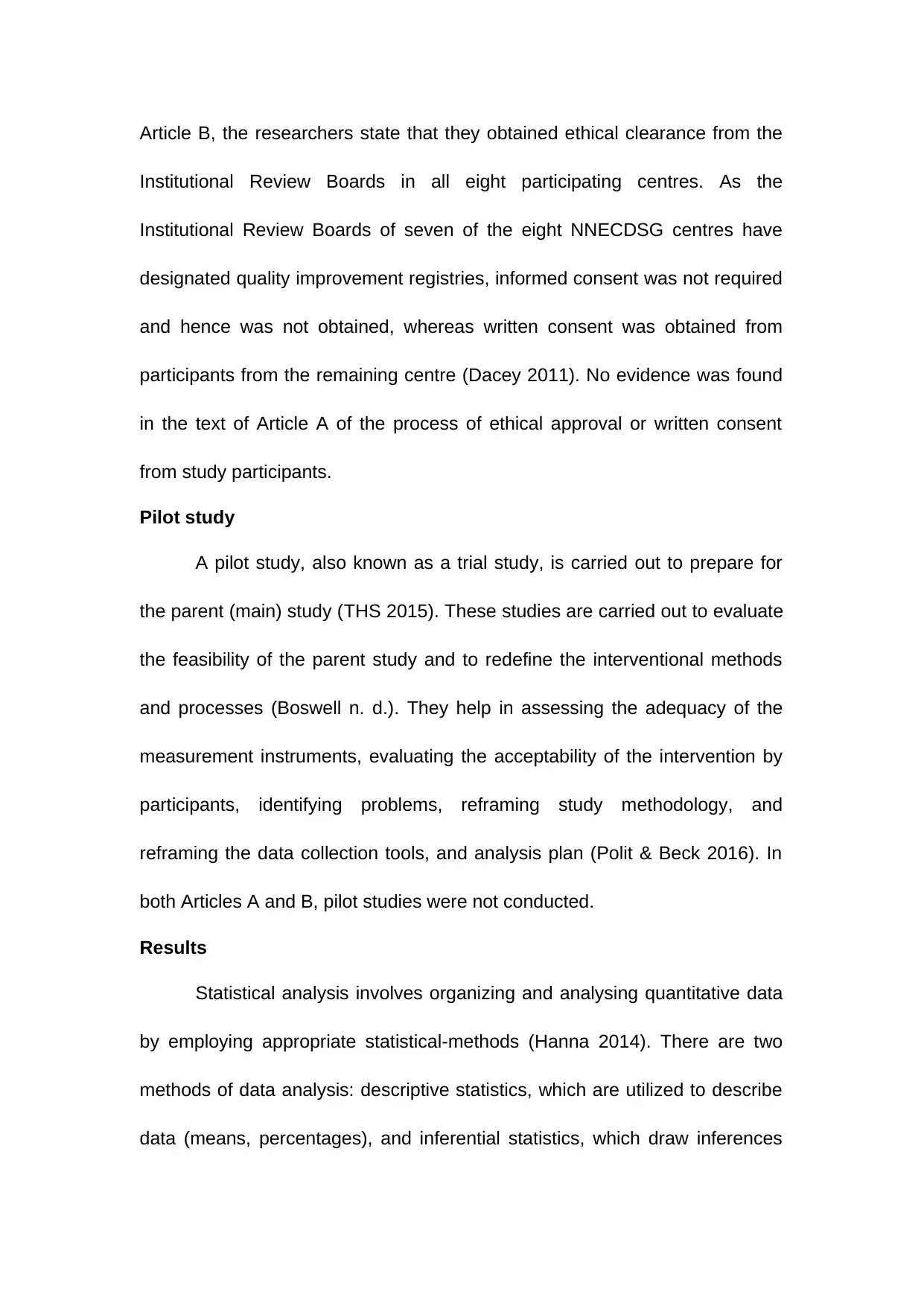
Article B, the researchers state that they obtained ethical clearance from the
Institutional Review Boards in all eight participating centres. As the
Institutional Review Boards of seven of the eight NNECDSG centres have
designated quality improvement registries, informed consent was not required
and hence was not obtained, whereas written consent was obtained from
participants from the remaining centre (Dacey 2011). No evidence was found
in the text of Article A of the process of ethical approval or written consent
from study participants.
Pilot study
A pilot study, also known as a trial study, is carried out to prepare for
the parent (main) study (THS 2015). These studies are carried out to evaluate
the feasibility of the parent study and to redefine the interventional methods
and processes (Boswell n. d.). They help in assessing the adequacy of the
measurement instruments, evaluating the acceptability of the intervention by
participants, identifying problems, reframing study methodology, and
reframing the data collection tools, and analysis plan (Polit & Beck 2016). In
both Articles A and B, pilot studies were not conducted.
Results
Statistical analysis involves organizing and analysing quantitative data
by employing appropriate statistical-methods (Hanna 2014). There are two
methods of data analysis: descriptive statistics, which are utilized to describe
data (means, percentages), and inferential statistics, which draw inferences
Institutional Review Boards in all eight participating centres. As the
Institutional Review Boards of seven of the eight NNECDSG centres have
designated quality improvement registries, informed consent was not required
and hence was not obtained, whereas written consent was obtained from
participants from the remaining centre (Dacey 2011). No evidence was found
in the text of Article A of the process of ethical approval or written consent
from study participants.
Pilot study
A pilot study, also known as a trial study, is carried out to prepare for
the parent (main) study (THS 2015). These studies are carried out to evaluate
the feasibility of the parent study and to redefine the interventional methods
and processes (Boswell n. d.). They help in assessing the adequacy of the
measurement instruments, evaluating the acceptability of the intervention by
participants, identifying problems, reframing study methodology, and
reframing the data collection tools, and analysis plan (Polit & Beck 2016). In
both Articles A and B, pilot studies were not conducted.
Results
Statistical analysis involves organizing and analysing quantitative data
by employing appropriate statistical-methods (Hanna 2014). There are two
methods of data analysis: descriptive statistics, which are utilized to describe
data (means, percentages), and inferential statistics, which draw inferences
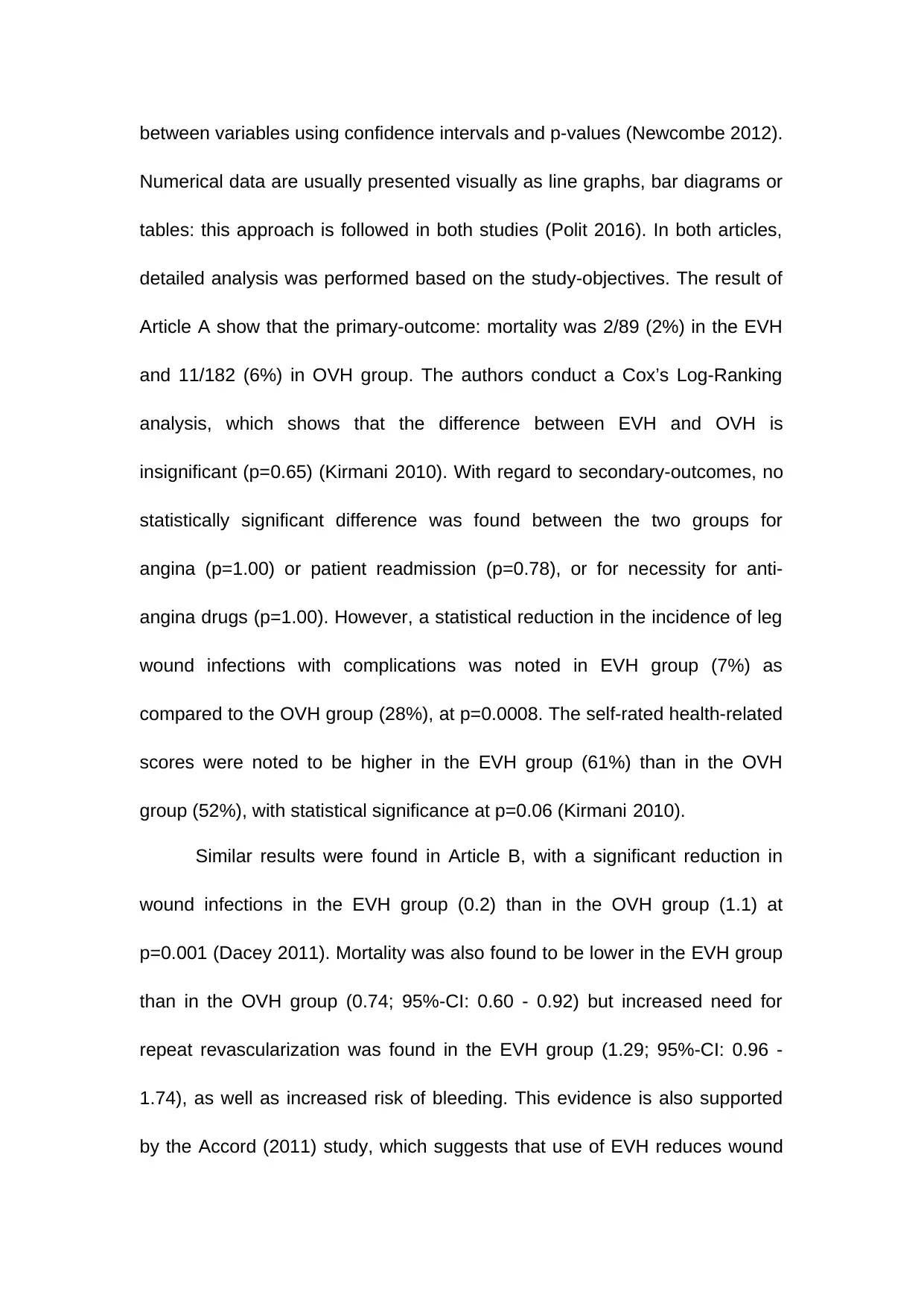
between variables using confidence intervals and p-values (Newcombe 2012).
Numerical data are usually presented visually as line graphs, bar diagrams or
tables: this approach is followed in both studies (Polit 2016). In both articles,
detailed analysis was performed based on the study-objectives. The result of
Article A show that the primary-outcome: mortality was 2/89 (2%) in the EVH
and 11/182 (6%) in OVH group. The authors conduct a Cox’s Log-Ranking
analysis, which shows that the difference between EVH and OVH is
insignificant (p=0.65) (Kirmani 2010). With regard to secondary-outcomes, no
statistically significant difference was found between the two groups for
angina (p=1.00) or patient readmission (p=0.78), or for necessity for anti-
angina drugs (p=1.00). However, a statistical reduction in the incidence of leg
wound infections with complications was noted in EVH group (7%) as
compared to the OVH group (28%), at p=0.0008. The self-rated health-related
scores were noted to be higher in the EVH group (61%) than in the OVH
group (52%), with statistical significance at p=0.06 (Kirmani 2010).
Similar results were found in Article B, with a significant reduction in
wound infections in the EVH group (0.2) than in the OVH group (1.1) at
p=0.001 (Dacey 2011). Mortality was also found to be lower in the EVH group
than in the OVH group (0.74; 95%-CI: 0.60 - 0.92) but increased need for
repeat revascularization was found in the EVH group (1.29; 95%-CI: 0.96 -
1.74), as well as increased risk of bleeding. This evidence is also supported
by the Accord (2011) study, which suggests that use of EVH reduces wound
Numerical data are usually presented visually as line graphs, bar diagrams or
tables: this approach is followed in both studies (Polit 2016). In both articles,
detailed analysis was performed based on the study-objectives. The result of
Article A show that the primary-outcome: mortality was 2/89 (2%) in the EVH
and 11/182 (6%) in OVH group. The authors conduct a Cox’s Log-Ranking
analysis, which shows that the difference between EVH and OVH is
insignificant (p=0.65) (Kirmani 2010). With regard to secondary-outcomes, no
statistically significant difference was found between the two groups for
angina (p=1.00) or patient readmission (p=0.78), or for necessity for anti-
angina drugs (p=1.00). However, a statistical reduction in the incidence of leg
wound infections with complications was noted in EVH group (7%) as
compared to the OVH group (28%), at p=0.0008. The self-rated health-related
scores were noted to be higher in the EVH group (61%) than in the OVH
group (52%), with statistical significance at p=0.06 (Kirmani 2010).
Similar results were found in Article B, with a significant reduction in
wound infections in the EVH group (0.2) than in the OVH group (1.1) at
p=0.001 (Dacey 2011). Mortality was also found to be lower in the EVH group
than in the OVH group (0.74; 95%-CI: 0.60 - 0.92) but increased need for
repeat revascularization was found in the EVH group (1.29; 95%-CI: 0.96 -
1.74), as well as increased risk of bleeding. This evidence is also supported
by the Accord (2011) study, which suggests that use of EVH reduces wound
⊘ This is a preview!⊘
Do you want full access?
Subscribe today to unlock all pages.

Trusted by 1+ million students worldwide
1 out of 20
Related Documents
Your All-in-One AI-Powered Toolkit for Academic Success.
+13062052269
info@desklib.com
Available 24*7 on WhatsApp / Email
![[object Object]](/_next/static/media/star-bottom.7253800d.svg)
Unlock your academic potential
Copyright © 2020–2025 A2Z Services. All Rights Reserved. Developed and managed by ZUCOL.




